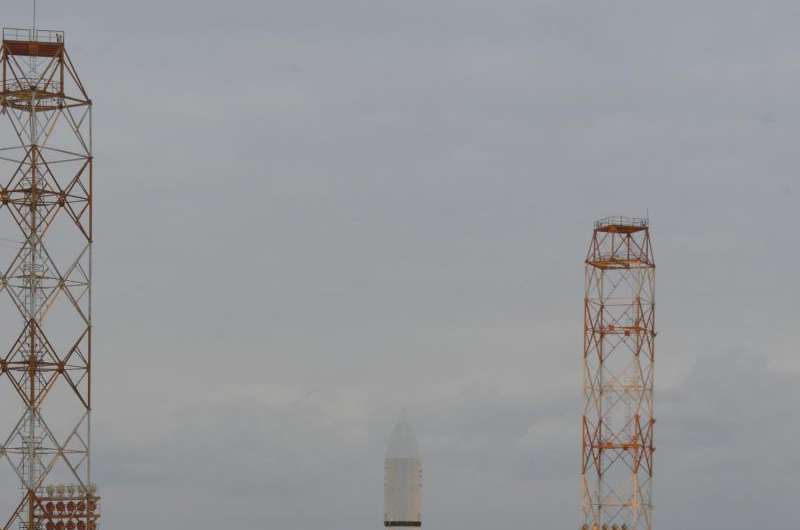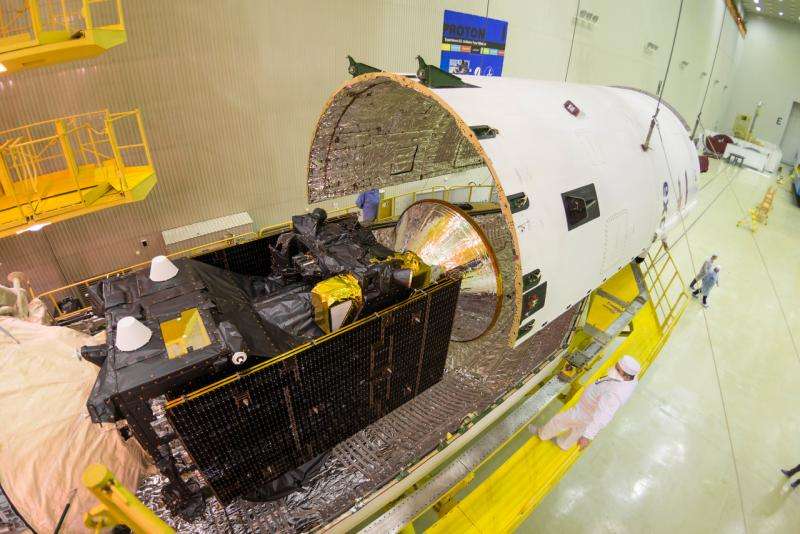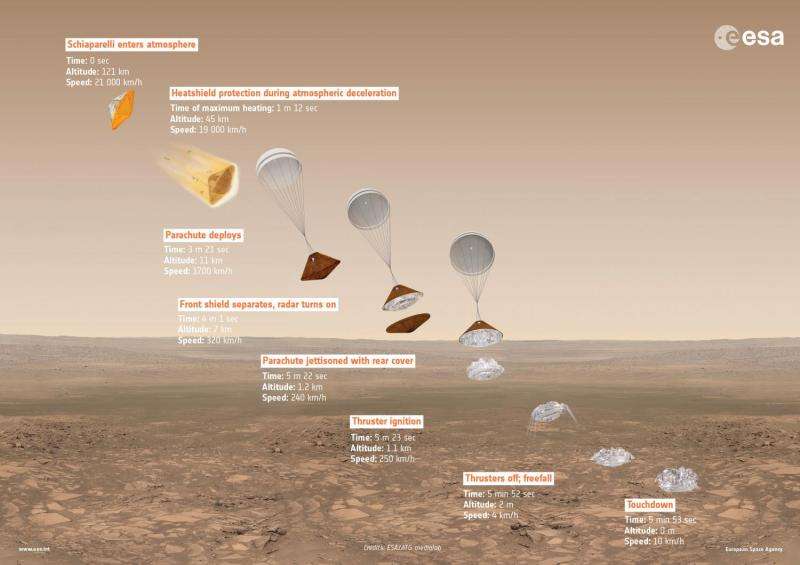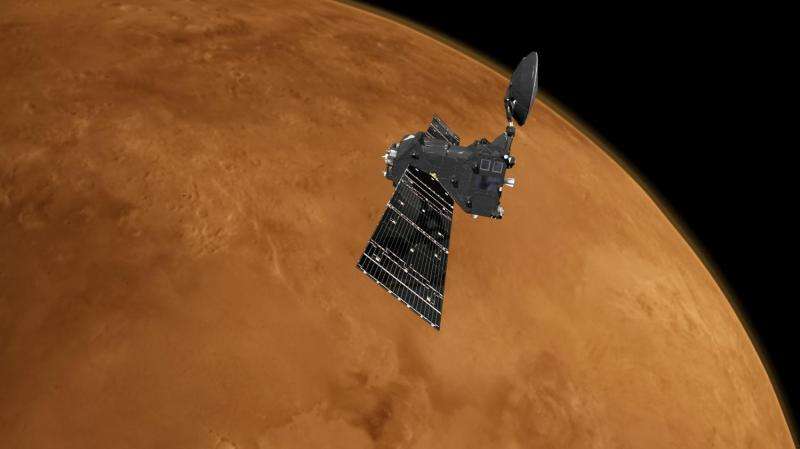ExoMars 2016 lifted off on a Proton-M rocket from Baikonur, Kazakhstan at 09:31 GMT on 14 March 2016. Credit: ESA–Stephane Corvaja, 2016
The first of two joint ESA-Roscosmos missions to Mars has begun a seven-month journey to the Red Planet, where it will address unsolved mysteries of the planet's atmosphere that could indicate present-day geological – or even biological – activity.
The Trace Gas Orbiter and the Schiaparelli entry, descent and landing demonstrator lifted off on a Proton-M rocket operated by Russia's Roscosmos at 09:31 GMT (10:31 CET) this morning from Baikonur, Kazakhstan.
Following separation of Proton's first and second stages, the payload fairing was released. The third stage separated nearly 10 minutes after liftoff.
The Breeze-M upper stage, with ExoMars attached, then completed a series of four burns before the spacecraft was released at 20:13 GMT (21:13 CET).
Signals from the spacecraft, received at ESA's control centre in Darmstadt, Germany via the Malindi ground tracking station in Africa at 21:29 GMT (22:29 CET), confirmed that the launch was fully successful and the spacecraft is in good health.
The orbiter's solar wings have also now unfolded and the craft is on its way to Mars.
"It's been a long journey getting the first ExoMars mission to the launch pad, but thanks to the hard work and dedication of our international teams, a new era of Mars exploration is now within our reach," says Johann-Dietrich Woerner, ESA's Director General.
Animation visualising milestones during the launch of the ExoMars 2016 mission and its cruise to Mars. The mission comprises the Trace Gas Orbiter and an entry, descent and landing demonstrator module, Schiaparelli, which are scheduled to be launched on a four-stage Proton-M/Breeze-M rocket from Baikonur during the 14–25 March 2016 window. About ten-and-a-half hours after launch, the spacecraft will separate from the rocket and deploy its solar wings. Two weeks later, its high-gain antenna will be deployed. After a seven-month cruise to Mars, Schiaparelli will separate from TGO on 16 October. Three days later it will enter the martian atmosphere, while TGO begins its entry into Mars orbit. Credit: ESA/ATG medialab
"I am grateful to our Russian partner, who have given this mission the best possible start today. Now we will explore Mars together."
Igor Komarov, General Director of the Roscosmos State Space Corporation, adds, "Only the process of collaboration produces the best technical solutions for great research results. Roscosmos and ESA are confident of the mission's success."
"We're not only looking forward to the world-class science data that this mission will return, but it is also significant in paving the way for the second ExoMars mission, which will move our expertise from in-orbit observations to surface and subsurface exploration of Mars," says Alvaro Giménez, ESA's Director of Science.
The ExoMars 2016 spacecraft composite, comprised of the Trace Gas Orbiter and Schiaparelli, seen during the encapsulation within the launcher fairing on 2 March. The conical shape to the left is the launch vehicle adapter, through which the spacecraft is attached to the Breeze upper stage. The first half of the fairing has already been rolled into place underneath the spacecraft assembly, and the second fairing half is being manoeuvred into place by an overhead crane. Credit: ESA – B. Bethge
The Trace Gas Orbiter (TGO) and Schiaparelli will travel to Mars together before separating on 16 October at distance of 900 000 km from the planet.
Then, on 19 October, Schiaparelli will enter the martian atmosphere, descending to the surface in just under six minutes.
Schiaparelli will demonstrate key entry, descent, and landing technologies for future missions, and will conduct a number of environmental studies during its short mission on the surface.
Overview of Schiaparelli’s entry, descent and landing sequence on Mars, with approximate time, altitude and speed of key events indicated. Schiaparelli is scheduled to separate from TGO on 16 October 2016, three days before arriving at Mars. Twelve hours after separation, the TGO will perform a course correction to avoid entering the atmosphere, and will continue into Mars orbit. Then, on 19 October, Schiaparelli will enter the atmosphere at an altitude of about 121 km and a speed of nearly 21 000 km/h. In the three to four minutes that follow, it will be slowed by the increasing atmospheric drag, with the front shield of the aeroshell bearing the brunt of the heating. This will slowly melt and vaporise, allowing the absorbed heat to be carried away from the rest of the spacecraft. Once the speed has decreased to around 1700 km/h Schiaparelli will be 11 km above the surface and a parachute will be deployed. The parachute canopy will unfurl in less than a second, and, 40 seconds later, allowing for oscillations to die down, the front shield of the aeroshell will be jettisoned. The parachute will slow Schiaparelli to around 250 km/h, and then the back half of the aeroshell, with the parachute attached to it, will also be jettisoned. It will be drawn rapidly away from Schiaparelli, which will now be completely free of the aeroshell that had kept it safe en route to Mars. Schiaparelli will then activate its three hydrazine thrusters to control its speed. Radar will continuously measure the height above the surface. At an altitude of around 2 m, Schiaparelli will briefly hover before cutting its thrusters, leaving it to free fall. The touchdown speed will be a few metres per second, with the impact absorbed by a crushable structure similar to the crumple zone in a car, on the underside of the lander, preventing damage to the rest of the module. The entire entry, descent and landing sequence will be complete in less than six minutes. Credit: ESA/ATG medialab
For example, it will obtain the first measurements of electric fields on the surface of Mars that, combined with measurements of the concentration of atmospheric dust, will provide new insights into the role of electric forces on dust lifting – the trigger for dust storms.
Meanwhile, on the same day, TGO will enter an elliptical four-day orbit around Mars, taking it from about 300 km at its nearest to around 96 000 km at its furthest point.
After a year of complex 'aerobraking', manoeuvres during which the spacecraft will use the planet's atmosphere to lower its orbit slowly to a circular 400 km, its scientific mission to analyse rare gases in the atmosphere will begin.
Artist’s impression of the ExoMars 2016 Trace Gas Orbiter at Mars. Credit: ESA/ATG medialab
Of particular interest is methane, which on Earth, points to active geological or biological processes.
One of the mission's key goals is to follow up on the methane detection made by ESA's Mars Express in 2004 to understand the processes at play in its generation and destruction, with an improved accuracy of three orders of magnitude over previous measurements.
TGO will also image features on the martian surface that may be related to trace-gas sources such as volcanoes. In addition, it will be able to detect buried water-ice deposits, which, along with locations identified as sources of the trace gases, could influence the choice of landing sites of future missions.
The orbiter will also act as a data relay for the second ExoMars mission, comprising a rover and stationary surface science platform, which is scheduled for launch in May 2018, arriving in early 2019.
Provided by European Space Agency


























